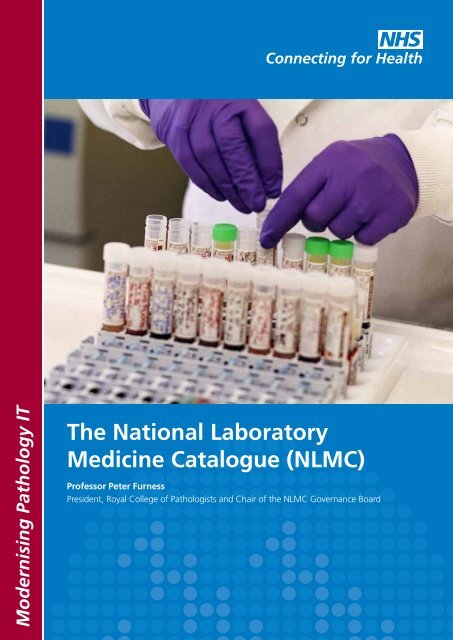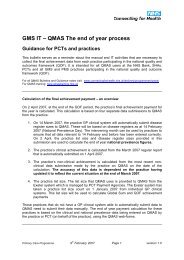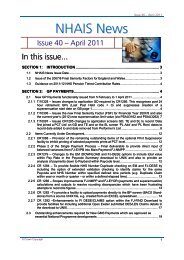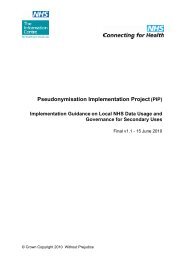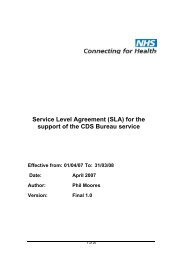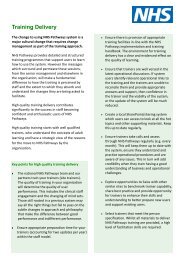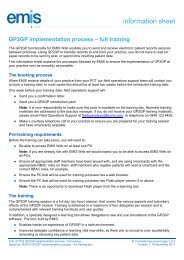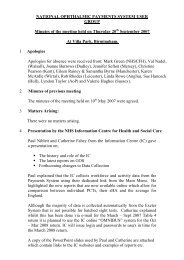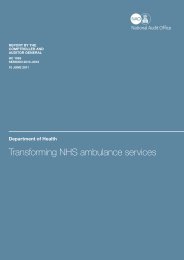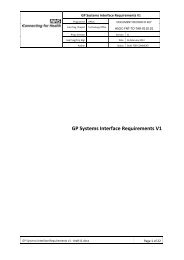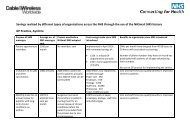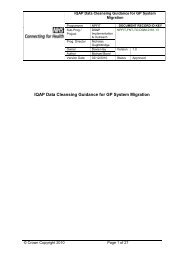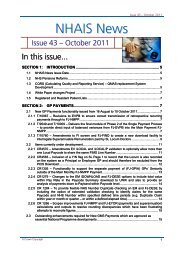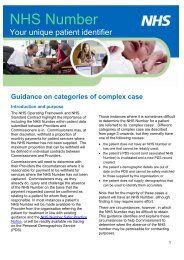The National Laboratory Medicine Catalogue (NLMC) - NHS ...
The National Laboratory Medicine Catalogue (NLMC) - NHS ...
The National Laboratory Medicine Catalogue (NLMC) - NHS ...
You also want an ePaper? Increase the reach of your titles
YUMPU automatically turns print PDFs into web optimized ePapers that Google loves.
Modernising Pathology IT<br />
<strong>The</strong> <strong>National</strong> <strong>Laboratory</strong><br />
<strong>Medicine</strong> <strong>Catalogue</strong> (<strong>NLMC</strong>)<br />
Professor Peter Furness<br />
President, Royal College of Pathologists and Chair of the <strong>NLMC</strong> Governance Board
It is surprising that the UK has not previously had a definitive list<br />
of the laboratory investigations that can be requested for the<br />
benefit of patient care. In respect of drugs, we have had the<br />
British <strong>National</strong> Formulary for many years. <strong>The</strong>re are mechanisms<br />
to decide what drugs should be included in the list; whether they<br />
are available only on prescription, whether they are ‘controlled’;<br />
the precise spelling of the single, unambiguous generic name and<br />
basic advice on how each drug should and should not be used.<br />
Professor Peter Furness<br />
In contrast, laboratory medicine tests do not have an ‘official’<br />
name. Different names in different settings may mean the same<br />
thing, or the same name may mean different things. <strong>The</strong>re is no<br />
national mechanism to agree whether or not a test is worth<br />
using. <strong>The</strong> result, when considered across the country, could be<br />
dangerous, is wasteful and confusing.<br />
This is about to change with the development of the <strong>National</strong><br />
<strong>Laboratory</strong> <strong>Medicine</strong> <strong>Catalogue</strong>. It is being established by the<br />
Department of Health (DH) the main driver being <strong>NHS</strong><br />
Connecting for Health (<strong>NHS</strong> CFH) and the implementation of<br />
electronic order communications as part of the electronic patient<br />
record. Computer systems tend to be less tolerant of variation in<br />
the way things are named than humans therefore minimising the<br />
error factor.<br />
<strong>The</strong> establishment of the <strong>NLMC</strong> will have far-reaching benefits.<br />
At the request of the DH, the Royal College of Pathologists have<br />
established a Governance Board to oversee the development of<br />
the <strong>NLMC</strong> and the quality assurance of catalogue content.<br />
This is an interesting time and I’m sure many across the health<br />
sector will welcome the <strong>National</strong> <strong>Laboratory</strong> <strong>Medicine</strong> <strong>Catalogue</strong>.<br />
Benefits<br />
• <strong>The</strong> <strong>NLMC</strong> will define a<br />
common terminology so that<br />
doctors across the country will<br />
use the same words when<br />
ordering laboratory tests or<br />
receiving results.<br />
• Results on a single named test<br />
delivered anywhere will be<br />
amenable to combination<br />
without risk of<br />
misinterpretation, whether<br />
by computer or by human<br />
intervention. This is crucial in<br />
the age of the electronic<br />
patient record.<br />
• A process to guide whether or<br />
not a test should be included in<br />
the catalogue will represent a<br />
national decision process on the<br />
clinical utility of a test,<br />
minimising the work needed for<br />
local evaluation and providing a<br />
focal point for research input<br />
and manufacturers who wish to<br />
see a new test adopted<br />
throughout the country.<br />
• <strong>The</strong> same test evaluation<br />
process will highlight gaps in<br />
our knowledge on test use,<br />
thereby guiding well-focussed<br />
translational research.<br />
• Codes associated with each<br />
test (SNOMED-CT ®) will<br />
facilitate seamless, reliable<br />
electronic linkage to and<br />
between other relevant<br />
databases (such as Labtests<br />
Online, Map of <strong>Medicine</strong> and<br />
others).<br />
• <strong>The</strong> process of evaluating tests<br />
for inclusion in the catalogue<br />
will, over time, generate a<br />
database of professional<br />
guidance on test use that will<br />
be made available to guide<br />
clinical use and interpretation –<br />
and avoid over-use.<br />
2
History<br />
Attempts have been made over several years to generate a national<br />
catalogue in laboratory medicine. Several local catalogues were<br />
merged, but every time a new local catalogue was added the size<br />
of the problem was highlighted; on every occasion a large number<br />
of new terms were added. Many of these were synonyms or<br />
alternate names. Some were needed to satisfy the idiosyncrasies of<br />
local computer systems of ways of working; some were clearly<br />
obsolete, but the end result was a huge, unwieldy list.<br />
Part of the problem was that this list was ‘pre-coordinated’, which<br />
means that the name of each request item actually represented a<br />
fusion of several separate elements. Even a simple entry such as<br />
‘urine sodium level’ is a concatenation of three elements; the<br />
substance to be evaluated (sodium), the collected sample type<br />
(urine) and the type of measurement (the concentration). In 2008<br />
it was decided that this ‘single list’ approach was unwieldy and<br />
would not work. <strong>The</strong> catalogue is now being converted to a ‘postcoordinated’<br />
form, akin to a relational database rather than a<br />
flat-file database. ‘Post-coordinated’ means that the full definition<br />
of each test can be produced as and when needed, from the<br />
separate modular lists of attributes within the catalogue.<br />
<strong>The</strong> Plan<br />
<strong>The</strong> core dataset in the catalogue will include a list under each of<br />
the following headings:<br />
• <strong>The</strong> full test request name, this will usually be a concatenation of<br />
the name of analyte or organism to be measured (e.g. ‘sodium’)<br />
and the type of measurement (e.g. ‘level’)<br />
• An associated character limited test request display name<br />
• Approved alternative test request display names<br />
• <strong>The</strong> SNOMED CT ® code for the test request and associated<br />
attributes where appropriate<br />
• <strong>The</strong> valid collected and analysed specimen types associated with<br />
a request (e.g. blood may be a valid collected specimen type with<br />
associated valid analysed specimen types of serum or plasma).<br />
<strong>The</strong>re will also be a mechanism to allow the definition of<br />
topography, morphology, laterality, test-specific specimen handling<br />
instructions and preferred units of measurement, as required.<br />
When deployed within a local system each organisation can choose<br />
which <strong>NLMC</strong> test requests to make visible to requesting clinicians as<br />
part of the local pathology services provided.<br />
3
<strong>The</strong> core principles of the catalogue will apply across all disciplines of<br />
laboratory medicine, but the consequences will vary considerably in<br />
different disciplines. For example, clinical chemistry will involve a large<br />
number of tests and a small number of specimen types; topography,<br />
morphology and laterality will rarely be important. In histopathology<br />
there will be few tests, perhaps only ‘histology’ and ‘cytology’; but the<br />
range of topology will cover the whole human anatomy.<br />
Initially the catalogue will be constructed to permit the development<br />
of electronic order communications solutions for clinicians to use,<br />
but the scope of the <strong>NLMC</strong> will expand over time to include ‘intralaboratory<br />
orderables’ (such as immunohistochemistry requests in<br />
histopathology or sub-typing of organisms in microbiology),<br />
‘reportable’ items and decision support.<br />
<strong>The</strong> Methods<br />
‘<strong>The</strong> core principles of<br />
the catalogue will apply<br />
across all disciplines of<br />
laboratory medicine,<br />
but the consequences<br />
will vary considerably in<br />
different disciplines.’<br />
<strong>The</strong> DH in collaboration with <strong>NHS</strong> Connecting for Health has<br />
established a <strong>NLMC</strong> Governance Board to oversee the development<br />
of the catalogue on behalf of the <strong>NHS</strong>. <strong>The</strong> Board is chaired and<br />
hosted by the Royal College of Pathologists and supported by a<br />
part-time <strong>NLMC</strong> executive team consisting of an appointed <strong>NLMC</strong><br />
Clinical Lead (Paul Collinson, Consultant Chemical Pathologist,<br />
St Georges Hospital, London), together with five specialty leads<br />
covering the main disciplines of laboratory medicine. <strong>The</strong> <strong>NLMC</strong><br />
Board and executive team are being funded by DH to work on this<br />
project, but they will need to recruit volunteer specialists to assist<br />
and advise them in review work. <strong>The</strong> existing unwieldy precoordinated<br />
list of tests has not been completely abandoned,<br />
because it represents a valuable check-list of the concepts that the<br />
new catalogue will need to cover. Compatibility with ‘legacy’<br />
computer systems will be maintained as far as possible. But the<br />
flat-file list has been converted to a post-coordinated set of lists, as<br />
explained above, and an online software tool has been created to<br />
facilitate its editing. <strong>The</strong> work of eliminating duplicates and<br />
improving consistency has begun. Protocols for editing the database<br />
are being developed and ultimately approval of changes will be the<br />
responsibility of the Governance Board.<br />
4<br />
Ref: 4454
<strong>The</strong> Future<br />
Milestones for the development of the catalogue will include the<br />
initial release date, implementation by users and approval by the<br />
Information Standards Board. <strong>The</strong> <strong>NLMC</strong> Governance Board is<br />
working closely with the UK Terminology Centre to ensure coding<br />
meets the necessary standards.. <strong>The</strong>se milestones apply only to the<br />
initial list of ‘clinician orderable’ items. <strong>The</strong> incorporation of intralaboratory<br />
orderables and reportable items will come next. Once the<br />
catalogue has documented the tests we use now, the major<br />
challenge for the future will be keeping the catalogue up to date.<br />
Decisions on whether the health service uses a new development<br />
should be based on the benefit it brings to patients; on its clinical<br />
utility. This is much harder to measure than parameters such as the<br />
sensitivity and specificity of a test. Demonstrating patient benefit<br />
from a new drug is notoriously difficult and expensive, but<br />
demonstrating patient benefit from a new diagnostic test can be<br />
even harder. For example, clinical trials of drugs are usually<br />
restricted to patients who have a specific disease. How do you<br />
define entry criteria for a diagnostic test, in a way that will allow<br />
meaningful evaluation of its clinical utility? If a test has utility in<br />
hospital, what does that mean in primary care? <strong>The</strong> <strong>National</strong><br />
Institute for Healthcare and Regulatory Excellence has always had a<br />
remit to cover diagnostics in addition to therapeutics, but so far it<br />
has had little impact in that field. This is set to change, with<br />
expansion of the work of NICE in diagnostics and a new set of<br />
methods more suited to the difficulties of working in this area. But<br />
it seems inevitable that NICE will still be unable to answer every<br />
question that arises. It will address the issues that are important, in<br />
terms of patient numbers, patient impact and cost to the <strong>NHS</strong>. But<br />
at the other extreme, it is unlikely that NICE will wish to consider<br />
whether or not a new antibody is helpful in the characterisation of<br />
a rare tumour. It is uncertain what other mechanisms will be<br />
required for the evaluation of diagnostic tests not undertaken by<br />
NICE; but it seems inevitable that the Governance Board will have<br />
to take some decisions on the content and the structure of the<br />
catalogue in relation to issues that NICE cannot handle. A ‘triage’<br />
mechanism to decide how each new development should best be<br />
handled has yet to be agreed.<br />
‘Once the catalogue has documented<br />
the tests we use now, the major<br />
challenge for the future will be<br />
keeping the catalogue up to date.’<br />
5
Making these decisions will demand the accumulation of evidence<br />
on the use of tests. That information must not be wasted, but<br />
should be made available to users, much as the British <strong>National</strong><br />
Formulary provides advice on drug use. This evidenced based route<br />
to the inclusion of new tests or new uses for established tests will<br />
be supplemented by work currently commissioned by DH on<br />
creating a decision support system for laboratory tests. This work<br />
includes a trawl of available information from a wide range of<br />
resources, creation of an editorial process to review the information<br />
acquired, transforming information in order that it answers users’<br />
questions and determining what electronic format is required to link<br />
to <strong>NLMC</strong>. Although not the initial priority of the catalogue team, a<br />
longer-term aim is to have an open and flexible approach to the<br />
generation of professional advice.<br />
<strong>The</strong> Stakeholders<br />
If you have read this far, you clearly have an interest in this process,<br />
so you (or, more probably, an organisation that you represent) may<br />
wish to become a <strong>National</strong> <strong>Laboratory</strong> <strong>Medicine</strong> <strong>Catalogue</strong><br />
stakeholder. This is the method by which we aim to ensure that the<br />
catalogue remains relevant and responsive to its users and the<br />
wider healthcare community. <strong>NLMC</strong> stakeholders will:<br />
• Obtain regular updates about the catalogue by email<br />
• Have online access to all <strong>NLMC</strong> documents, including minutes of<br />
meetings, operating procedures, editorial principles etc.<br />
• Be invited to express opinions and advice to the Governance<br />
Board at any time<br />
• Be invited to an annual stakeholder meeting to exchange views<br />
on how the catalogue is developing.<br />
Stakeholders can propose themselves for acceptance by email to<br />
anne.boxill@rcpath.org . <strong>The</strong> Governance Board will decide on<br />
admission to the list, but we do not intend to be unduly restrictive.<br />
We hope to hold the first stakeholder’s meeting in December 2009.<br />
Further information regarding the <strong>NLMC</strong> can be found here:<br />
http://www.connectingforhealth.nhs.uk/systemsandservices/<br />
pathology/modernising/projects/nlmc<br />
Any further questions regarding the <strong>NLMC</strong> in general can be sent<br />
to cfh.nlmc-pathology@nhs.net in the first instance.<br />
6<br />
Ref: 4558


